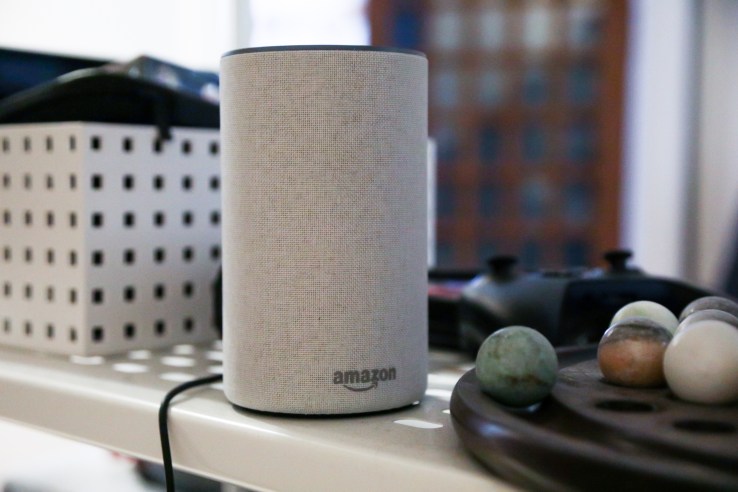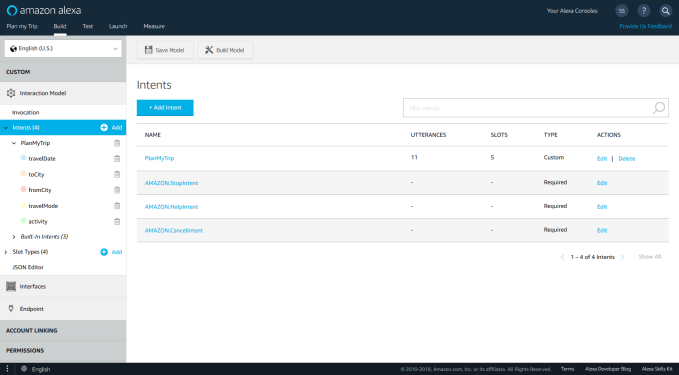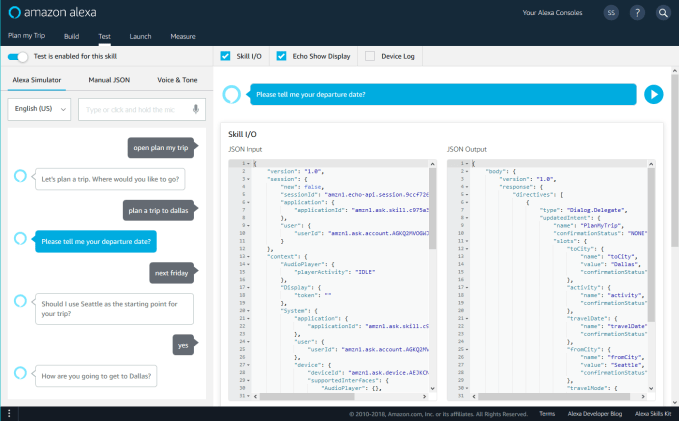

Amazon today is rolling out the biggest makeover for its Alexa Skills Kit Developer Console – the console where voice app developers create their skills – since its debut back in 2015. The new console has been redesigned with a focus on improving developer workflows, says Amazon. It now offers separate sections for “build,” “test,” “launch,” and “measure” – meaning developers can create skills in a visual interface, test their performance, push them live, then see how consumers respond in order to make adjustments.
The redesign comes at a time when a number of third-party companies have stepped in to address issues that Amazon’s own toolset has been lacking. For example, Sayspring created a visual interface for designers to prototype their voice apps ahead of coding, and YC-backed Storyline allows for Alexa skill development without coding.
While Amazon’s own developer console doesn’t address those exact same use cases, there is a bigger emphasis on visualizing the flow of the conversation with Alexa than in the previous version.

Now, developers will have a visual interface for creating skill components, like intents, slots, sample utterances, and the dialog model.

Afterwards, they can test their skill in the console using either voice or text – including multi-turn dialog – while seeing the conversation play out in the left-hand sidebar.
The “Launch” page will help developers address common validation errors, and offers support for publishing private skills for Alexa for Business. (Before, these business skills could only be published using the Alexa Skills Kit Command Line Interface.)
And in “Measure,” developers can track metrics around sessions, utterances, unique customers, and now, cohort analysis, too. This will help them better understand their customer retention and engagement over time.
Above: The old and new experience, side-by-side
“We’re constantly introducing new features for developers to enhance skill building and management, and one piece of feedback we received from developers was for a simplification of the workflow,” explains Amazon’s Paul Cutsinger, Head of Alexa Voice Design Education. “We took developer feedback and used it to improve the site structure and information architecture. The new developer console makes navigation easier with an updated and integrated user interface,” he says. “Developers can create and manage their skill in one integrated environment with a built-in checklist and validation support at each step.”
Overall, the new skill builder does look like a more modern piece of software, is now branded with Alexa’s logo and blue color scheme, and appears less intimidating to newcomers to Alexa skill building as a result of the redesign.

However, the software is still in beta and Amazon warns that while it can handle most skills, there are some features that are unsupported for the time being.
Part of the battle for smart speaker market share is keeping the developer community happy. On that front, Amazon has a mixed track record. While it has a bigger end user base for smart speaker voice apps thanks to Echo’s popularity, the apps have so far been somewhat difficult to monetize, despite Amazon’s more recent support for in-app purchases and subscriptions.
Many developers are doing voice apps as more of a hobby, in the hopes that the ecosystem will develop over time. Other apps built by larger companies are seen more as the cost of doing business – if you’re Uber, for example, or a smart home device maker or a news publisher, you have to establish your presence on the platform.
The new Alexa Skills Kit developer console (beta) is live here.

